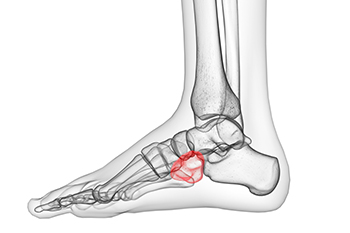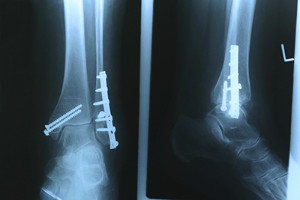Items filtered by date: August 2021
Cuboid Syndrome and Running
 Cuboid syndrome is a condition in which the cuboid bone, located near the center of the foot, becomes displaced. If you’re a runner, this is a problem that you should watch out for. Your feet absorb shock up to two and a half times your body weight when you run. When all of the foot bones are properly aligned, your feet can absorb the shock without much discomfort. However, when the cuboid bone is displaced the feet can’t absorb shock as efficiently leading to foot pain, swelling, reduced range of motion, and difficulty bearing weight on the affected foot. Cuboid syndrome may occur in conjunction with an ankle sprain, or it can be caused by poor foot biomechanics or injury. If you are experiencing any foot pain please seek the care of a podiatrist.
Cuboid syndrome is a condition in which the cuboid bone, located near the center of the foot, becomes displaced. If you’re a runner, this is a problem that you should watch out for. Your feet absorb shock up to two and a half times your body weight when you run. When all of the foot bones are properly aligned, your feet can absorb the shock without much discomfort. However, when the cuboid bone is displaced the feet can’t absorb shock as efficiently leading to foot pain, swelling, reduced range of motion, and difficulty bearing weight on the affected foot. Cuboid syndrome may occur in conjunction with an ankle sprain, or it can be caused by poor foot biomechanics or injury. If you are experiencing any foot pain please seek the care of a podiatrist.
Cuboid syndrome, also known as cuboid subluxation, occurs when the joints and ligaments near the cuboid bone in the foot become torn. If you have cuboid syndrome, consult with Dr. Steven Sheridan from Ankle & Foot Specialty Clinics. Our doctor will assess your condition and provide you with quality foot and ankle treatment.
Cuboid syndrome is a common cause of lateral foot pain, which is pain on the outside of the foot. The condition may happen suddenly due to an ankle sprain, or it may develop slowly overtime from repetitive tension through the bone and surrounding structures.
Causes
The most common causes of cuboid syndrome include:
- Injury – The most common cause of this ailment is an ankle sprain.
- Repetitive Strain – Tension placed through the peroneus longus muscle from repetitive activities such as jumping and running may cause excessive traction on the bone causing it to sublux.
- Altered Foot Biomechanics – Most people suffering from cuboid subluxation have flat feet.
Symptoms
A common symptom of cuboid syndrome is pain along the outside of the foot which can be felt in the ankle and toes. This pain may create walking difficulties and may cause those with the condition to walk with a limp.
Diagnosis
Diagnosis of cuboid syndrome is often difficult, and it is often misdiagnosed. X-rays, MRIs and CT scans often fail to properly show the cuboid subluxation. Although there isn’t a specific test used to diagnose cuboid syndrome, your podiatrist will usually check if pain is felt while pressing firmly on the cuboid bone of your foot.
Treatment
Just as the range of causes varies widely, so do treatments. Some more common treatments are ice therapy, rest, exercise, taping, and orthotics.
If you have any questions, please feel free to contact our office located in Sandusky, MI . We offer the newest diagnostic and treatment technologies for all your foot care needs.
What Can Cause Pain on the Outside of the Foot?
 There are a variety of conditions that lead to foot pain. Pain in different areas of the foot can indicate different problems. Many of the conditions that cause pain on the outside of the foot can indicate cuboid syndrome, a peroneus brevis tendon injury, a midtarsal joint sprain, a Jones fracture, sinus tarsi syndrome, or peroneal tendonitis. Cuboid syndrome occurs when the cuboid bone becomes partially dislocated. A midtarsal joint sprain occurs when the ligaments that hold the midtarsal joints together become inflamed or torn. A Jones fracture, which usually occurs during sports, happens when the 5th metatarsal bone on the outside of the foot becomes fractured or broken. Because of the variety of reasons that foot pain can occur, patients who are suffering from foot pain should consult with a podiatrist for a proper diagnosis and treatment of their condition.
There are a variety of conditions that lead to foot pain. Pain in different areas of the foot can indicate different problems. Many of the conditions that cause pain on the outside of the foot can indicate cuboid syndrome, a peroneus brevis tendon injury, a midtarsal joint sprain, a Jones fracture, sinus tarsi syndrome, or peroneal tendonitis. Cuboid syndrome occurs when the cuboid bone becomes partially dislocated. A midtarsal joint sprain occurs when the ligaments that hold the midtarsal joints together become inflamed or torn. A Jones fracture, which usually occurs during sports, happens when the 5th metatarsal bone on the outside of the foot becomes fractured or broken. Because of the variety of reasons that foot pain can occur, patients who are suffering from foot pain should consult with a podiatrist for a proper diagnosis and treatment of their condition.
Foot Pain
Foot pain can be extremely painful and debilitating. If you have a foot pain, consult with Dr. Steven Sheridan from Ankle & Foot Specialty Clinics. Our doctor will assess your condition and provide you with quality foot and ankle treatment.
Causes
Foot pain is a very broad condition that could be caused by one or more ailments. The most common include:
- Bunions
- Hammertoes
- Plantar Fasciitis
- Bone Spurs
- Corns
- Tarsal Tunnel Syndrome
- Ingrown Toenails
- Arthritis (such as Gout, Rheumatoid, and Osteoarthritis)
- Flat Feet
- Injury (from stress fractures, broken toe, foot, ankle, Achilles tendon ruptures, and sprains)
- And more
Diagnosis
To figure out the cause of foot pain, podiatrists utilize several different methods. This can range from simple visual inspections and sensation tests to X-rays and MRI scans. Prior medical history, family medical history, and any recent physical traumatic events will all be taken into consideration for a proper diagnosis.
Treatment
Treatment depends upon the cause of the foot pain. Whether it is resting, staying off the foot, or having surgery; podiatrists have a number of treatment options available for foot pain.
If you have any questions, please feel free to contact our office located in Sandusky, MI . We offer the newest diagnostic and treatment technologies for all your foot care needs.
What Can Alleviate Gout Pain?
Gout, a condition which commonly affects the feet is often accompanied by intense pain and discomfort. The joints in the big toe are typically the most affected by gout. Common symptoms can include debilitating pain which can often make walking difficult or even impossible. Gout is caused by an excess of purines in the blood and can develop as a result of different factors like genetics and frequently eating foods that have high purine levels. These types of foods can include shellfish, alcohol, red meat, or drinks that have large amounts of sugar. Some patients have found mild relief from gout attacks by minimizing the pressure that is put on the affected foot. Additionally, it may be beneficial to elevate the foot as this may help to reduce a portion of the existing swelling. If you are affected by gout, it is strongly suggested that you are under the care of a podiatrist who can help you to manage this condition.
Gout is a foot condition that requires certain treatment and care. If you are seeking treatment, contact Dr. Steven Sheridan from Ankle & Foot Specialty Clinics. Our doctor will treat your foot and ankle needs.
What Is Gout?
Gout is a type of arthritis caused by a buildup of uric acid in the bloodstream. It often develops in the foot, especially the big toe area, although it can manifest in other parts of the body as well. Gout can make walking and standing very painful and is especially common in diabetics and the obese.
People typically get gout because of a poor diet. Genetic predisposition is also a factor. The children of parents who have had gout frequently have a chance of developing it themselves.
Gout can easily be identified by redness and inflammation of the big toe and the surrounding areas of the foot. Other symptoms include extreme fatigue, joint pain, and running high fevers. Sometimes corticosteroid drugs can be prescribed to treat gout, but the best way to combat this disease is to get more exercise and eat a better diet.
If you have any questions please feel free to contact our office located in Sandusky, MI . We offer the newest diagnostic and treatment technologies for all your foot and ankle needs.
Heel Pain Can Affect More Than the Heel
One common cause of heel pain is a condition known as plantar fasciitis. Research indicates that plantar fasciitis accounts for approximately eighty percent of all cases of heel pain. Plantar fasciitis can produce severe pain and discomfort and can cause difficulty in walking. Changing the way you walk to minimize heel pain can have adverse effects on your posture and the biomechanics of your feet, knees, and hips which in turn, may lead to problems or pain in these areas. Plantar fasciitis can occur as a result of standing for extended periods of time, or from wearing shoes that do not fit correctly. Additionally, it can be caused by a sudden injury or from an abnormal foot structure. The heel can be affected by an Achilles tendon injury, which can gradually occur from overuse. This can affect the ability to point and flex the foot and can make it difficult to complete daily activities. There are several other causes of heel pain in addition to plantar fasciitis, and it is suggested that you schedule an appointment with a podiatrist who can effectively diagnose and treat heel pain conditions.
Many people suffer from bouts of heel pain. For more information, contact Dr. Steven Sheridan of Ankle & Foot Specialty Clinics. Our doctor can provide the care you need to keep you pain-free and on your feet.
Causes of Heel Pain
Heel pain is often associated with plantar fasciitis. The plantar fascia is a band of tissues that extends along the bottom of the foot. A rip or tear in this ligament can cause inflammation of the tissue.
Achilles tendonitis is another cause of heel pain. Inflammation of the Achilles tendon will cause pain from fractures and muscle tearing. Lack of flexibility is also another symptom.
Heel spurs are another cause of pain. When the tissues of the plantar fascia undergo a great deal of stress, it can lead to ligament separation from the heel bone, causing heel spurs.
Why Might Heel Pain Occur?
- Wearing ill-fitting shoes
- Wearing non-supportive shoes
- Weight change
- Excessive running
Treatments
Heel pain should be treated as soon as possible for immediate results. Keeping your feet in a stress-free environment will help. If you suffer from Achilles tendonitis or plantar fasciitis, applying ice will reduce the swelling. Stretching before an exercise like running will help the muscles. Using all these tips will help make heel pain a condition of the past.
If you have any questions please contact our office located in Sandusky, MI . We offer the newest diagnostic and treatment technologies for all your foot and ankle needs.
Gout Pain Can Be Managed
Recovery Tips for a Stress Fracture
 A stress fracture is defined as a hairline fracture that is generally the result of stress the bones endure from high impact activities such as running. Because of this, the feet and lower legs are often susceptible to developing a stress fracture. It is beneficial to implement adequate recovery procedures, despite the fact that many athletes choose to run through the pain and discomfort. A full recovery often begins with refraining from running for approximately four to six weeks, in addition to performing strengthening and flexibility exercises. If the stress fracture is severe, a boot may be worn for stability as the healing process occurs. If you have pain in your foot that increases gradually, it is strongly suggested that you visit a podiatrist who can diagnose and treat any potential stress fractures.
A stress fracture is defined as a hairline fracture that is generally the result of stress the bones endure from high impact activities such as running. Because of this, the feet and lower legs are often susceptible to developing a stress fracture. It is beneficial to implement adequate recovery procedures, despite the fact that many athletes choose to run through the pain and discomfort. A full recovery often begins with refraining from running for approximately four to six weeks, in addition to performing strengthening and flexibility exercises. If the stress fracture is severe, a boot may be worn for stability as the healing process occurs. If you have pain in your foot that increases gradually, it is strongly suggested that you visit a podiatrist who can diagnose and treat any potential stress fractures.
Stress fractures occur when there is a tiny crack within a bone. To learn more, contact Dr. Steven Sheridan from Ankle & Foot Specialty Clinics. Our doctor can provide the care you need to keep you pain free and on your feet.
How Are They Caused?
Stress fractures are the result of repetitive force being placed on the bone. Since the lower leg and feet often carry most of the body’s weight, stress fractures are likely to occur in these areas. If you rush into a new exercise, you are more likely to develop a stress fracture since you are starting too much, too soon. Pain resulting from stress fractures may go unnoticed at first, however it may start to worsen over time.
Risk Factors
- Gender – They are more commonly found in women compared to men.
- Foot Problems – People with unusual arches in their feet are more likely to develop stress fractures.
- Certain Sports – Dancers, gymnasts, tennis players, runners, and basketball players are more likely to develop stress fractures.
- Lack of Nutrients – A lack of vitamin D and calcium may weaken the bones and make you more prone to stress fractures
- Weak Bones – Osteoporosis can weaken the bones therefore resulting in stress fractures
Stress fractures do not always heal properly, so it is important that you seek help from a podiatrist if you suspect you may have one. Ignoring your stress fracture may cause it to worsen, and you may develop chronic pain as well as additional fractures.
If you have any questions, please feel free to contact our office located in Sandusky, MI . We offer the newest diagnostic and treatment technologies for all your foot care needs.
Support Devices for Broken Ankles
 A broken ankle bone often takes at least six weeks to fully heal. During the recovery period, your doctor may require you to wear a support device to limit the ankle’s movement and protect it. Usually a support device for an ankle fracture is either a brace, cast, or splint. Ankle braces are typically lightweight, pull-on garments that immobilize the joint and provide heat and compression. A splint may be more restrictive and minimizes movement while stabilizing the ankle joint. A cast is the most restrictive, encasing the affected ankle, and is designed to keep the ankle completely immobile. It is important to follow your doctor’s instructions to achieve full recovery. If you have fractured your ankle, it is suggested that you seek the care of a podiatrist.
A broken ankle bone often takes at least six weeks to fully heal. During the recovery period, your doctor may require you to wear a support device to limit the ankle’s movement and protect it. Usually a support device for an ankle fracture is either a brace, cast, or splint. Ankle braces are typically lightweight, pull-on garments that immobilize the joint and provide heat and compression. A splint may be more restrictive and minimizes movement while stabilizing the ankle joint. A cast is the most restrictive, encasing the affected ankle, and is designed to keep the ankle completely immobile. It is important to follow your doctor’s instructions to achieve full recovery. If you have fractured your ankle, it is suggested that you seek the care of a podiatrist.
Broken ankles need immediate treatment. If you are seeking treatment, contact Dr. Steven Sheridan from Ankle & Foot Specialty Clinics. Our doctor can provide the care you need to keep you pain-free and on your feet.
Broken Ankles
A broken ankle is experienced when a person fractures their tibia or fibula in the lower leg and ankle area. Both of these bones are attached at the bottom of the leg and combine to form what we know to be our ankle.
When a physician is referring to a break of the ankle, he or she is usually referring to a break in the area where the tibia and fibula are joined to create our ankle joint. Ankles are more prone to fractures because the ankle is an area that suffers a lot of pressure and stress. There are some obvious signs when a person experiences a fractured ankle, and the following symptoms may be present.
Symptoms of a Fractured Ankle
- Excessive pain when the area is touched or when any pressure is placed on the ankle
- Swelling around the area
- Bruising of the area
- Area appears to be deformed
If you suspect an ankle fracture, it is recommended to seek treatment as soon as possible. The sooner you have your podiatrist diagnose the fracture, the quicker you’ll be on the way towards recovery.
If you have any questions, please feel free to contact our office located in Sandusky, MI . We offer the newest diagnostic and treatment technologies for all your foot care needs.



